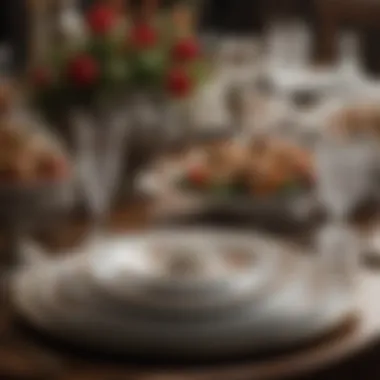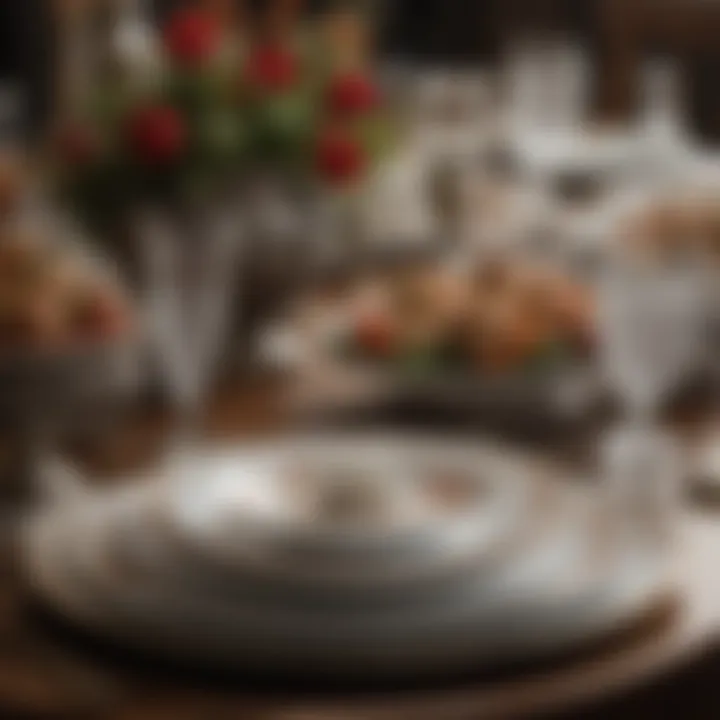Mastering the Art of Elegant Dinner Table Settings


Intro
Setting an elegant dinner table is more than just placing dishes and cutlery. It is an expression of hospitality and an art form that can elevate the dining experience. Understanding the nuances of table settings allows hosts to create a memorable atmosphere for guests, whether for a formal event or a casual gathering. This comprehensive guide will unravel the essentials of place settings, covering everything from the arrangement of utensils to the intricacies of dinner etiquette. The aim is to provide clarity and structure, enabling readers to master the art of table arrangement.
Creating an inviting table environment involves a thoughtful blend of design elements and practicality. Knowing the significance of each item on the table and its appropriate placement directly impacts the dining experience. This guide will delve deeply into the details, ensuring that each aspect of table setting is articulated clearly and concisely.
A well-set table invites conversation and warmth, making every meal a cherished occasion.
Prelude to Dinner Table Settings
Setting a dinner table is not just an act of placing items in order; it’s an art that reflects culture, personal style, and attentiveness to detail. In this guide, we aim to unravel the layers of importance that come with thoughtful table settings. This introductory section emphasizes the significance of mastering the basics of dinner table settings for any occasion.
The first point to consider is the impact that well-designed table settings have on the dining experience. An elegant table speaks volumes about the host’s effort in creating a memorable atmosphere. It elevates the meal, prompting guests to appreciate not only the food but also the overall ambiance. Crafting a welcoming table encourages engagement among diners, enhancing conversations and enjoyment during the meal.
Another crucial element to highlight is the variety of dinner settings required for different occasions. Formal gatherings necessitate a more structured approach, involving specific placement and etiquette. Conversely, informal settings allow for creativity and comfort. Understanding these distinctions ensures that you are prepared for any social context.
"The setup of a dinner table serves as an invitation to a unique experience, where every detail counts."
Moreover, consideration of the appropriate elements—tableware, cutlery, glassware, and linens—contributes significantly to the dining aesthetic. Each piece should be chosen to reflect the occasion's tone while also ensuring practical functionality.
Being aware of geographical, cultural, and personal preferences further adds depth to your table setting. Different cultures have unique customs around dining, which can inspire the decor. Incorporating elements that resonate with your guests’ backgrounds can create a shared experience that deepens connections.
In essence, this section sets the foundation for comprehending why table settings should not be overlooked. They represent an integral part of hospitality. This guide will ensure that you are well-equipped to create an elegant dinner table that can transform any meal into a remarkable affair.
Understanding the Importance of Table Settings
Dinner table settings are more than just a practical necessity; they embody a significant aspect of social gatherings and dining experiences. The way a table is set influences not only the aesthetic quality of the meal but also the atmosphere in which it is enjoyed. Understanding the importance of table settings can enhance interactions among guests and set the stage for memorable occasions.
Cultural Significance
Table settings often reflect cultural traditions and customs. Different cultures have distinct practices when it comes to dining. For instance, in many Western societies, using multiple utensils for different courses is common, while in some Asian cultures, chopsticks are preferred. These variations highlight how table settings can showcase cultural heritage and promote understanding among diners.
Moreover, certain dining etiquettes are rooted in cultural significance, such as the placement of the fork and knife or even the choice of dinnerware. Learning about these customs can enrich one’s appreciation for other cultures, making the dining experience more meaningful. For instance, during a formal occasion, following specific setting guidelines can evoke respect for tradition and enhance the overall atmosphere.
Aesthetic Appeal
An elegantly set table captivates visually. A well-arranged table serves not only as a functional space for food but also as a canvas for creativity. When considering the aesthetic elements of table settings, one must think about color, texture, and arrangement. These factors contribute to the overall vibe of a meal.
Using contrasting colors in table linens, tableware, and centerpieces can create a striking visual appeal. Light-colored tablecloths paired with darker cutlery or colorful glassware can evoke a cohesive, sophisticated look. Similarly, the choice of materials—such as ceramic plates versus glass—adds depth to the table’s appearance.
Another key aspect is the symmetry and balance in arrangement. A beautifully balanced table can be achieved by evenly distributing plates, cutlery, and glassware on the table. This not only appears deliberate but also enhances the dining experience by making it feel organized and inviting.
In essence, the importance of table settings cannot be overstated. They serve as an expression of culture and art, contributing significantly to the overall experience of any dining occasion. A well-thought-out table arrangement ensures that diners feel welcomed and appreciated, which is vital in hosting any meal.
Essential Elements of Dinner Table Setting
Dinner table settings encompass various components that contribute to the overall dining experience. A well-set table speaks to the host's attention to detail and enhances the meal's enjoyment. Essential elements include tableware, cutlery, glassware, and linens. Each plays a significant role in creating a harmonious environment. Understanding these elements ensures practical use and aesthetic quality in table arrangements, catering to diverse dining occasions.
Tableware
Tableware consists of plates, bowls, and serving dishes, forming the foundation of any meal setup. This category is critical as it dictates the meal's visual appeal and functionality.
Plates
Plates are the primary component of tableware. Their size and design can dramatically impact the presentation of food. For formal occasions, larger dinner plates are often preferred, allowing ample space for artful food arrangement. The type of material, such as porcelain or stoneware, affects durability and style. Porcelain plates are widely used due to their elegant appearance and resilience.
A unique feature of plates lies in their versatility. They can be used for various courses, from appetizers to desserts. However, one must consider the size and depth of the plates to avoid meals appearing overcrowded, directly affecting the overall dining experience.
Bowls
Bowls serve as functional containers for soups, salads, and side dishes. Their depth allows for easier serving and consumption of various food types. They often come in different materials, including ceramic and glass, which can enhance the table's aesthetics.
The key characteristic of bowls is their ability to focus attention on the food while allowing for a more casual dining approach. A disadvantage is that they may require additional utensils, complicating the setting if not managed well. Ensuring the right variety of bowls is crucial for a cohesive table setting.
Serving Dishes
Serving dishes are essential for presenting food to guests, adding an element of shareability to the meal. They come in multiple forms, including platters and casserole dishes. This variety allows for creative presentations.
Their notable feature is the significant role they play in serving ample portions to guests, fostering communal dining. However, one must account for their size on the table. Oversized serving dishes can crowd the setting, reducing accessibility to individual place settings.
Cutlery
Cutlery includes knives, forks, and spoons, indispensable for the dining experience. The arrangement of cutlery reflects dining etiquette and enhances ease of use throughout the meal.
Knives
Knives are crucial for cutting and enjoying various foods. Their design, with a sharp edge and comfortable handle, is important for effective use. Steak knives or butter knives may be implemented depending on the course being served.
A key characteristic to note is that knives should always be placed with the blade facing the plate. This placement not only outlines proper etiquette but also addresses safety concerns. Ensuring each guest has the appropriate knife for their meal enhances dining efficiency.
Forks
Forks are essential instruments for picking up food, making their variety critical. Common types include dinner forks, salad forks, and dessert forks. Different fork sizes enable guests to enjoy their meals comfortably.


The defining characteristic of forks is their prongs, which should be designed to hold food securely. This tool's advantage is its straightforward design, which does not require special skills. However, having too many types of forks can sometimes confuse guests about their usage.
Spoons
Spoons are equally vital to a completed place setting. They are available in forms such as soup spoons and dessert spoons. Their shape facilitates scooping and consuming various dish types effectively.
A significant feature of spoons is their usability in both formal and informal settings. However, one must ensure they align with the meal course to provide a seamless dining experience. Misplaced spoon types can lead to confusion.
Glassware
Glassware comprises wine glasses, water glasses, and champagne flutes, adding sophistication to table settings. Well-selected glassware elevates the dining experience, enhancing drink presentation and enjoyment.
Wine Glasses
Wine glasses are designed specifically for serving wine, influencing its aroma and flavor experience. Each type has its form, catering to different kinds of wine, such as red or white.
The key characteristic is their bowl shape, which allows the wine to breathe. Moreover, using distinct glasses for various wines emphasizes the host's attention to detail. The disadvantage, however, is the need for appropriate cleaning and care, as delicate glasses can be prone to breakage.
Water Glasses
Water glasses are essential in any meal, providing hydration alongside food. These glasses come in various shapes and sizes, but typically, they are shorter and wider than wine glasses.
Their significant role is to complement meals without overwhelming the table's aesthetic. They offer a practical aspect, ensuring guests have access to water throughout the dining experience. The downside could be the large number of glass choices, which might clutter the table if not arranged effectively.
Champagne Flutes
Champagne flutes are particularly stylish, designed for serving sparkling beverages. Their narrow shape keeps the drink's bubbles intact while enhancing visual appeal.
A unique feature of champagne flutes is their height. This contrast can create a striking visual when set alongside other glasses. However, their delicate nature demands proper handling to avoid breakage, which can be an inconvenience during a gathering.
Linens
Linens encompass tablecloths, napkins, and table runners, playing a significant role in defining the table's mood and style. These elements help in setting the tone for the dining experience, offering both functionality and aesthetics.
Tablecloths
Tablecloths serve as the foundation for table protection and decoration. Available in various materials, such as cotton or polyester, they can significantly enhance the table's visual attractiveness while offering protection from spills.
The key feature of tablecloths is their ability to unify the table setting. This can make any arrangement feel complete. Still, they can sometimes be prone to staining, depending on the fabric chosen.
Napkins
Napkins provide both practicality and elegance at the dining table. They come in various materials and designs, emphasizing the table’s decor while allowing guests to clean their hands and mouths during the meal.
A notable characteristic is their versatility, as they can be folded in various ways to match the table’s theme. However, simpler designs might be overlooked if not coordinated effectively with the table decor, making their selection critical.
Table Runners
Table runners are decorative linens placed atop the tablecloth. They add an extra layer of texture and can be used to create visual interest and unify the overall table setup.
The unique feature of table runners is their ability to delineate space on a larger table. They can serve as a focal point, guiding the eye to specific decorative elements. Yet, one must ensure that runners do not disrupt the arrangement of tableware and cutlery, which can make the setting appear disorganized.
Understanding these essential elements is vital in crafting a refined dining experience. Each component contributes distinctly to the table's aesthetics and functionality, ensuring a successful and enjoyable meal.
Steps to Set a Proper Dinner Table
Setting a proper dinner table is not merely a decorative task but a crucial aspect of creating an inviting and functional dining experience. The arrangement of various elements contributes significantly to the overall dining atmosphere and enhances the meal experience for everyone present. Proper setting provides aesthetic value while practical considerations ensure smooth proceedings during the meal. Thus, understanding the steps involved in table setting is essential.
Preparation Before Setting the Table
Before a table can be set, preparation is key. This initial phase sets the tone for the entire dinner experience. Effective preparation includes selecting an appropriate space, gathering required items, and ensuring cleanliness to create a pleasing dining environment.
Choosing the Right Space
The choice of space is foundational in setting a dinner table. It impacts not only the physical layout but also the ambiance of the meal. A spacious room allows for easier movement, whereas a cozy area can foster intimacy. A well-chosen location can highlight the table and menu, making the dining experience enjoyable.
One key characteristic of selecting a space is light. Natural light, if possible, enriches the overall feel. However, the absence of natural light should be compensated with appropriate lighting fixtures. This enhances the aesthetics of the setting and engages guests positively.
Gathering Necessary Items
Gathering the necessary items is another crucial step. This process helps avoid unnecessary delays when the guests arrive. Having everything ready and in one place allows for a more organized approach to table setting. When laying the table, having all the elements at hand streamlines the process significantly.
The key characteristic here is organization. By using a checklist, one can ensure all items — including cutlery, glassware, and linens — are accounted for. A unique feature of this step is the opportunity to personalize the arrangement, allowing for thematic expression that resonates with the occasion.
Ensuring Cleanliness
The aspect of cleanliness is vital in creating an enjoyable dining experience. It transcends mere surface tidiness; it speaks to the care that has gone into meal preparation and hosting. Clean dishes, polished utensils, and spotless linens contribute to an overall positive presentation.
A core feature of ensuring cleanliness is the visual appeal it creates. It communicates to guests that their comfort and experience are prioritized. Attention to detail in this aspect reflects well on the host, supporting a positive dining atmosphere.
Arranging the Tableware
The arrangement of tableware follows preparation. This step is where the practical and aesthetic elements converge to create a pleasing table display. The positioning of dishes and utensils needs to be functional as well.


Placement of Plates
The placement of plates is a primary aspect of the table arrangement. Ideally, the dinner plate should sit directly in front of each seat at the table. This arrangement is not only essential for practicality but also for visual symmetry.
One key characteristic of plate placement is functionality. Guests should find it easy to reach their plates without obstruction. A unique feature involves using chargers beneath dinner plates. Chargers provide an elegant backdrop and can elevate the presentation considerably.
Using Chargers
Chargers are large plates placed beneath the dinnerware but are typically not used for serving food. Their main purpose is to add an extra layer of elegance to the setting. They can be beneficial in presenting a sophisticated appearance while also providing a protective layer for the table.
Their unique feature is versatility; they can adapt to various themes and color schemes. However, on the downside, if used improperly, chargers can clutter the table space, diminishing overall functionality.
Aligning Serving Dishes
Aligning serving dishes appropriately is another critical aspect. Typically, serving dishes should be positioned at strategic points on the table for ease of access. This ensures that guests can serve themselves without hindrance.
The key characteristic here is accessibility. Dishes should not only be visually pleasing but also easy for diners to reach. A unique feature is the use of trays to align multiple serving dishes; however, this can sometimes lead to overcrowding, requiring careful consideration of table size.
Positioning the Cutlery
Cutlery positioning is crucial for facilitating a smooth dining experience. Properly placed utensils allow guests to enjoy their meal efficiently and comfortably.
Forks on the Left
Traditionally, forks are placed to the left of the plate. This follows standard dining etiquette, making it easier for users to navigate the utensils without confusion. The arrangement aligns with the natural hand movements of guests.
Ultimately, this setup encourages efficiency in dining. However, it is essential to ensure that forks are not overcrowded on one side, which could create confusion during the meal.
Knives and Spoons on the Right
Placing knives and spoons on the right follows similar traditional guidelines. This arrangement complements the placement of forks, creating a balanced and intuitive setup. The knife should be positioned with the blade facing the plate, directing focus toward the food.
A key characteristic of this arrangement is its simplicity. It provides clarity in use. Nonetheless, one should avoid overcrowding; a messy arrangement can detract from the eating experience.
Order of Use
Following the order of utensil usage is an important guide. Typically, the rule is to use the outermost utensils first, working inward with each course. This guideline helps maintain a smooth dining flow.
Unique here is the educational aspect; it provides guests with cues on how to approach each course. Yet, an improper order can confuse guests, making it crucial to maintain clarity and simplicity in the setting.
Arranging Glassware
Glassware arrangement involves considering both the type and location of glasses in relation to plates. This setting serves both aesthetic and practical purposes.
Placement Relative to Plates
Glassware should be positioned above the knives on the right side of the plate. This arrangement promotes a clean and straightforward approach to accessing beverages during the meal, minimizing disturbances.
The key characteristic here is symmetry in placement. Glasses of varying height can add visual interest if arranged correctly. However, a common disadvantage is potential overcrowding, which can block sightlines and create chaos.
Types of Glasses by Course
Different courses often call for specific types of glasses. For example, red and white wine glasses, as well as champagne flutes, should be strategically distributed according to the food served. The varied styles contribute to an enhanced dining experience.
A unique feature of this aspect is the opportunity for thematic coordination. Yet, excessive types can clutter the table if not well-thought-out.
Adding Linens and Centerpieces
Linens and centerpieces provide the finishing touches to a well-set table. These elements add personality and charm to the dining experience.
Choosing Appropriate Linens
Linens should align with the overall theme of the dinner, be it formal or casual. Various fabric choices and colors can reflect the event's mood while contributing to the visual appeal of the dining setting.
The key characteristic of choosing linens is their versatility. They can dramatically change the atmosphere of a dinner. However, overly busy patterns can detract from other elements, so moderation is advisable.
Creating a Focal Point
Centerpieces serve as a focal point in the dining arrangement. They should be coordinated with the theme without overwhelming the table. A well-selected centerpiece enhances visual engagement, drawing guests' eyes naturally.
Here, the characteristic is balance. The centerpiece needs to be striking yet not obstructive. Overly tall centerpieces can hinder conversation; hence, height should be carefully considered.
Balancing the Overall Aesthetic
Creating balance in the overall aesthetic involves ensuring harmonization among all elements—tableware, glassware, linens, and centerpieces. This balance contributes to a cohesive dining experience that pleases the eyes and engages diners throughout the meal.
The inherent characteristic of balance is the creation of synergy. Every piece should work together to create a pleasing ambiance. A common challenge is ensuring such balance without overwhelming the space with too many elements.
Understanding Formal vs. Informal Settings
Understanding the differences between formal and informal table settings is crucial for any dining experience. Each setting serves a purpose and reflects specific social norms and etiquette. In this section, we will explore what defines a formal setting versus an informal one. Additionally, we will discuss the benefits and considerations that come with each type, enhancing your overall understanding of table arrangements.
Defining Formal Settings


A formal setting is typically associated with structured events, where tradition and etiquette are at the forefront. These occasions range from weddings and gala dinners to corporate events. The key characteristic of a formal setting is its emphasis on precision and detail. Each element on the table, from the type of china to the arrangement of cutlery, serves a defined purpose in enhancing the dining experience.
The unique feature of formal settings lies in their complexity. For example, it often includes multiple courses, requiring various utensils and glassware. This adds an air of sophistication, making formal settings a beneficial choice for occasions where impression matters. However, the intricate arrangement can also become overwhelming, particularly for those who may be unfamiliar with the customs.
Occasions for Formal Settings
Formal settings are commonly seen in high-profile events. These include:
- Weddings
- Corporate banquets
- Exclusive dinners
The contribution of these settings to the overall goal of dining etiquette cannot be overstated. They showcase respect for the occasion and the guests, providing a sophisticated backdrop that enhances the food and experience.
However, one disadvantage to consider is the potential stiffness it may instill in social interactions. Guests may feel constrained by rules, which may inhibit genuine engagement.
Detailed Arrangement Guidelines
Setting a formal table involves stringent guidelines. These include the placement of plates, cutlery, and glassware, ensuring everything is symmetrically aligned.
Key characteristics include:
- The charger plate at the base for each setting
- Forks placed to the left, knives and spoons to the right
- Wine glasses placed above the knife
These detailed guidelines provide clarity and cohesion to the dining experience. The structured approach helps lift the venue's atmosphere and increases the overall visual appeal. However, for those inexperienced in formal settings, mastering these guidelines can pose a challenge.
Defining Informal Settings
Contrasting with formal settings, informal settings offer a relaxed atmosphere where guests can feel at home. Parties among friends, family gatherings, and casual dinners fall into this category. The main characteristic of informal settings is their flexibility. There are fewer rules and more room for personal expression in arrangement.
The informal setup allows for creativity, which can be a beneficial aspect for hosts looking to make the dining experience more personal. However, the lack of structure can also lead to confusion regarding utensil placement or serving order if not managed wisely.
Occasions for Informal Settings
Informal table settings are best suited for relaxed gatherings:
- Family dinners
- Backyard barbecues
- Casual brunches
These occasions highlight the beauty of simplicity and the importance of enjoying the company rather than adhering to rigid dining rules. The unique feature of informal settings is the opportunity they provide for guests to feel comfortable and engaged. However, the potential drawback is that the casual nature might lead to less attention to detail.
More Relaxed Arrangement Guidelines
In informal settings, the guidelines for arrangement are more lenient. Here are some common practices:
- Plates can be set directly on the table without chargers
- Cutlery can vary depending on the meal, with less emphasis on order
- Glassware may include a single type for all drinks
These relaxed guidelines contribute to a more inviting atmosphere. While they allow for ease, they could also result in less visual appeal compared to their formal counterparts, as they may lack the same elegance and careful arrangement.
"Understanding the distinction between formal and informal settings empowers hosts to create the suitable dining environment for their guests, enhancing not just functionality but also enjoyment."
In summary, understanding formal versus informal settings is essential for successful table arrangements. Both styles have unique characteristics, advantages, and disadvantages that cater to different occasions and preferences.
Common Mistakes to Avoid
Mistakes in table setting can dilute both the aesthetic and the functional quality of your dining experience. For those who aim to impress, understanding these common pitfalls is crucial. By avoiding these mistakes, you can create a more organized, pleasing, and memorable dinner setting. Let us explore three typical errors that detract from a well-set table.
Overcrowding the Table
A table brimming with dishes, glassware, and decorations may seem visually appealing at first glance. However, overcrowding the table can lead to chaos rather than elegance. When each item competes for attention, the overall harmony of the setting is lost.
- Accessibility: A cluttered table makes it difficult for diners to reach their items. This can lead to awkwardness and discomfort during the meal.
- Visual Balance: Generating a sense of balance is key in table settings. An overloaded table often results in a chaotic look, lacking the calming effect of symmetry or strategic design.
- Practicality: Ensure there is enough space for each guest to enjoy their meal comfortably. A well-set table should promote pleasant conversation and ease of access.
Ignoring Theme Coordination
Setting a dinner table without a coherent theme can diminish the overall experience. A consistent motif not only provides guidance in selection of tableware but also unifies the elements on display.
- Color Scheme: Choosing colors that complement each other can create a more pleasing visual environment. Consider utilizing seasonal themes, such as pastels for spring or rich tones for fall.
- Style Compatibility: Pairing vintage items with modern ones can result in a disjointed look. Ensuring that items like plates, cutlery, and linens adhere to a particular style can enhance the dining ambiance.
- Mood Setting: The theme should echo the mood you wish to create, whether it is formal elegance, casual comfort, or a festive celebration.
Neglecting Practicality
A beautifully set table should not just be about aesthetics; practicality also matters significantly. Neglecting to consider ease of use could compromise the dining experience.
- Functional Items: Ensure that each piece of tableware serves a purpose. For example, having the appropriate utensils for each course prevents awkward exchanges during the meal.
- Serving Access: Plates and serving dishes should be placed in ways that promote easy serving and sharing among guests. Designate areas for common dishes to simplify the process.
- Adaptability: A table should be adaptable to the meal type. For instance, a simpler setting may work better for a casual meal while a complex arrangement might be reserved for a more formal event.
By recognizing these common mistakes and addressing them, you lay a solid foundation for an elegant dining experience.
Avoiding overcrowded arrangements, ensuring theme alignment, and maintaining practicality will enable you to master the art of table settings and delight your guests.
Closure: Mastering the Art of Table Setting
The art of table setting reflects a broader understanding of hospitality and etiquette. When you master this, you enhance the overall dining experience for your guests. A well-set table communicates care and attention, making each meal special. Here is why it is significant to grasp the elements involved in setting an elegant dinner table.
To begin with, a properly arranged table elevates the meal experience. Each element, from cutlery to glassware, informs your guests about what to expect. For instance, knowing where to place forks and knives creates an intuition about the proper usage. This eliminates confusion, especially in formal settings. Guests can focus more on enjoying the food and conversation rather than worrying about the correct utensils.
Moreover, impressive table settings can greatly affect the aesthetic appeal of your dining space. A well-curated table complements the occasion. Occasions such as birthdays or anniversaries can be enhanced with themed decorations, which provide an engaging visual experience. It is essential to consider colors, textures, and arrangements that flow together harmoniously.
Practicality must not be overlooked. While elegance and aesthetics are important, a functional layout promotes comfort. Ensure enough space between items to allow for easy access to food and drinks. Guests should not feel cramped or overwhelmed by a cluttered table.
"The true measure of a successful table setting is the balance between elegance and practicality."
As you continue to explore the nuances of table settings, remember that practice makes perfect. Each event provides new opportunities to refine your skills. A dedication to detail and a genuine care for your guests will elevate your hosting capabilities. By applying these principles, you can create dining experiences that leave a lasting impression.



